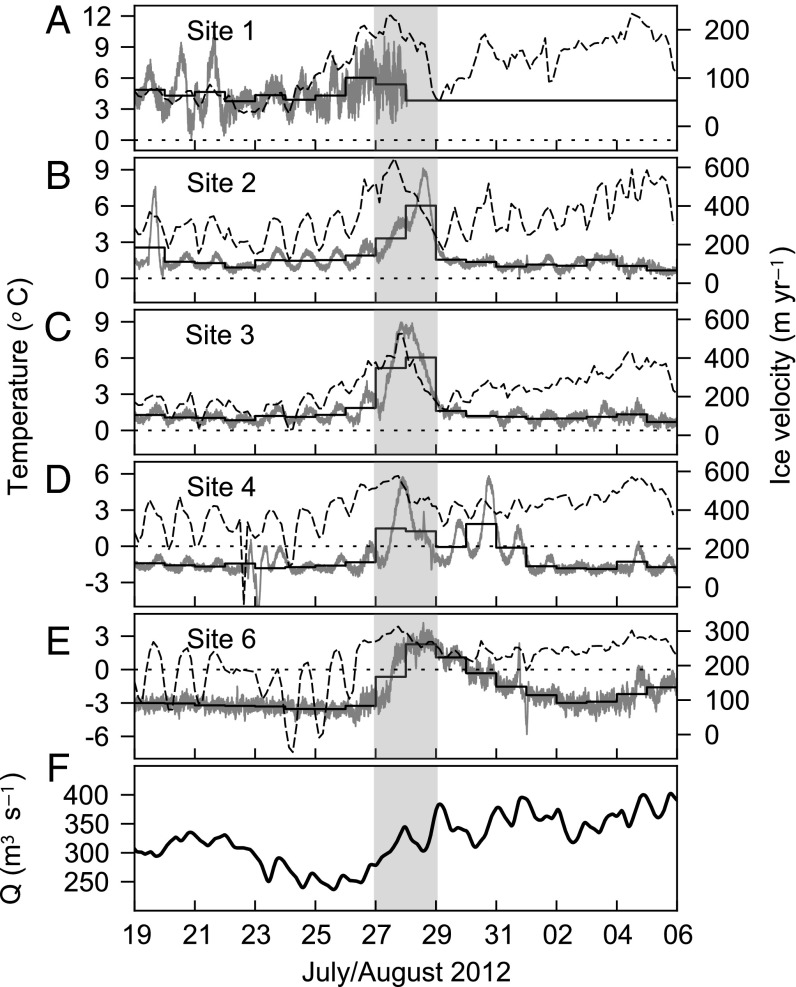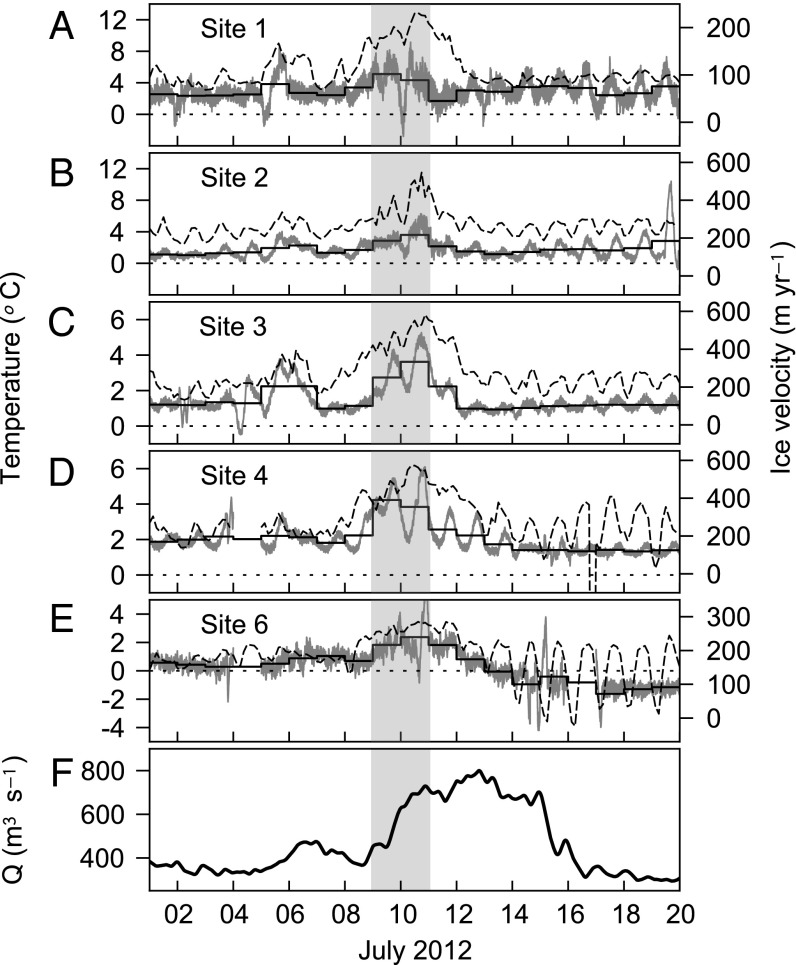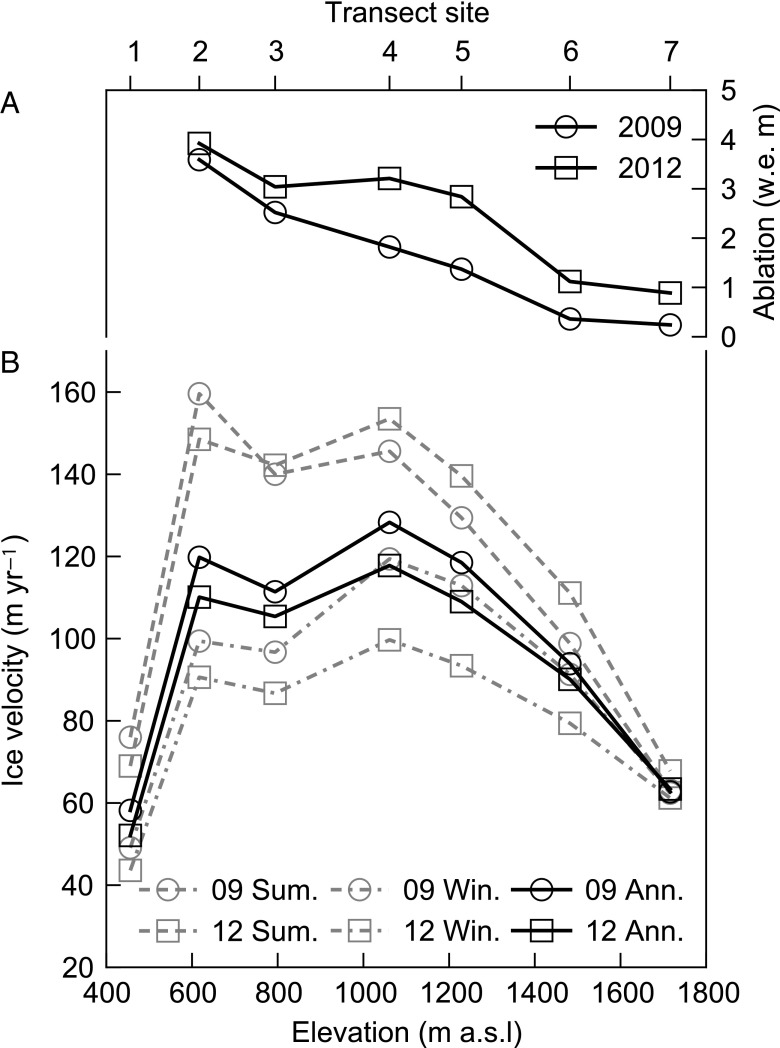Significance
During summer, meltwater generated on the Greenland ice sheet surface accesses the ice sheet bed, lubricating basal motion and resulting in periods of faster ice flow. However, the net impact of varying meltwater volumes upon seasonal and annual ice flow, and thus sea level rise, remains unclear. In 2012, despite record ice sheet runoff, including two extreme melt events, ice at a land-terminating margin flowed more slowly than in the average melt year of 2009, due principally to slower winter flow following faster summer flow. Our findings suggest that annual motion of land-terminating margins of the ice sheet, and thus the projected dynamic contribution of these margins to sea level rise, is insensitive to melt volumes commensurate with temperature projections for 2100.
Keywords: ice sheet dynamics, ice sheet hydrology, ice sheet melt, global positioning systems
Abstract
Changes to the dynamics of the Greenland ice sheet can be forced by various mechanisms including surface-melt–induced ice acceleration and oceanic forcing of marine-terminating glaciers. We use observations of ice motion to examine the surface melt–induced dynamic response of a land-terminating outlet glacier in southwest Greenland to the exceptional melting observed in 2012. During summer, meltwater generated on the Greenland ice sheet surface accesses the ice sheet bed, lubricating basal motion and resulting in periods of faster ice flow. However, the net impact of varying meltwater volumes upon seasonal and annual ice flow, and thus sea level rise, remains unclear. We show that two extreme melt events (98.6% of the Greenland ice sheet surface experienced melting on July 12, the most significant melt event since 1889, and 79.2% on July 29) and summer ice sheet runoff ∼3.9σ above the 1958–2011 mean resulted in enhanced summer ice motion relative to the average melt year of 2009. However, despite record summer melting, subsequent reduced winter ice motion resulted in 6% less net annual ice motion in 2012 than in 2009. Our findings suggest that surface melt–induced acceleration of land-terminating regions of the ice sheet will remain insignificant even under extreme melting scenarios.
Surface melting and runoff from the Greenland ice sheet (GrIS) has increased during the last 30 y (1–3) coincident with Northern Hemisphere warming (4, 5) resulting in unprecedented melt extents (6) and widespread dynamic thinning, which has penetrated up to 120 km into the ice sheet interior (7). One potential dynamic thinning mechanism is surface melt–induced acceleration of ice sheet motion (termed hydrodynamic coupling) during summer (8–11). Observations of GrIS ice motion during the summer show considerable variability over a range of timescales (12). Rapid variations in meltwater input from the ice sheet surface to the glacier bed result in periods when the subglacial drainage system is more highly pressurized, leading to an increase in basal sliding (13, 14). This mechanism explains both multiday increases in ice motion at the beginning of the melt season, analogous to the “spring events” observed at alpine glaciers (15), and increases in velocity at other times when meltwater is delivered to the bed at a rate faster than the subglacial drainage system can expand to accommodate.
However, as the drainage-system capacity gradually expands in response to increased melting, the subglacial water pressure falls and higher velocities can therefore only be caused by much larger meltwater pulses than earlier in the melt season (16). This feedback mechanism has been invoked previously to suggest that the ice sheet could flow more slowly in a warmer year, but observations have either been limited to close to the ice sheet margin (17) or have been unable to resolve the seasonal behavior responsible for the velocity variations (18). A recent study, which incorporated seasonal ice flow and melt observations extending beyond the equilibrium line, showed that summer velocity enhancement is negated by subsequent reductions in winter flow rates (19), but the bounding conditions of the study have since been exceeded by the exceptional melting observed in 2012 (20). Moreover, the current paucity of field observations is a significant impediment to modeling the impact of coupled hydrodynamics on net ice-mass loss (21).
The recent trend of warmer summers in Greenland is related to an increase in the frequency of anticyclonic conditions (22). Persistent anticyclonic conditions during summer 2012 resulted in extreme runoff volumes from the Greenland ice sheet (23), compounded by unprecedented melt extent in July 2012 associated with low-level liquid clouds (24), which led to flood damage such as the destruction of the Watson River bridge in Kangerlussuaq, west Greenland. These conditions resulted in a year during which ice sheet–wide runoff set a new record at ∼3.9σ above the 1958–2011 mean (23). National Centers for Environmental Prediction/National Center for Atmospheric Research reanalysis 1,000-mb temperature anomalies above Kangerlussuaq (25 km west of our site 1) relative to the 1981–2010 mean were +2.2 °C during May–August 2012, compared with ±0.3 °C during May–August 2009. The 2012 melt season is therefore a surrogate for potential future melting and forms a natural test for quantifying the effect of extreme meltwater supply on ice motion compared with the “average” melt year of 2009.
We used global positioning system (GPS) records to observe ice motion during 2009 and 2012 at seven sites along a transect on a land-terminating margin of the GrIS, at ∼67°N (Fig. 1). Air temperature and annual ablation were also measured at each site. The lowest three sites on the transect are located within Leverett Glacier’s inferred hydrological catchment, from which we measured bulk runoff (25). Transect dynamics during 2012 (Fig. 2) had similar characteristics to previous years (10, 19): initiation of meltwater-induced acceleration during multiday “spring” speed-up events, followed by shorter duration spikes in velocity superimposed on gradually declining background seasonal velocities, which fell below premelt season velocities by the end of summer.
Fig. 1.
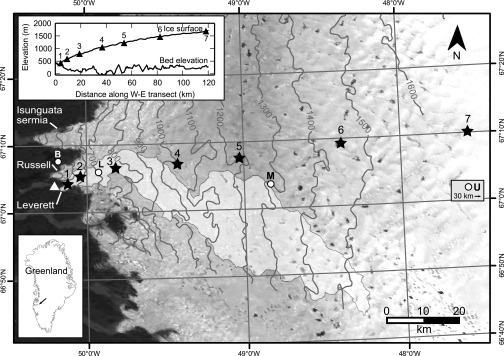
Location of the transect on the western margin of the GrIS. Stars indicate sites where ice motion, temperature, and seasonal melting were measured. The triangle indicates where proglacial discharge was measured and the GPS base station located. Circles indicate locations of ‘KAN’ PROMICE/GAP weather stations along the K transect. Contours (in meters) are from a digital elevation model (DEM) of the ice sheet surface produced from interferometric synthetic aperture radar (InSAR) (29). The inferred hydrological catchment of Leverett Glacier, delineated in light gray, was calculated from the ice sheet surface DEM. Inset shows surface and bed elevation along our transect as measured by IceBridge ATM (ILATM2) and MCoRDS (IRMCR2) in 2010 and 2011, respectively (30).
Fig. 2.
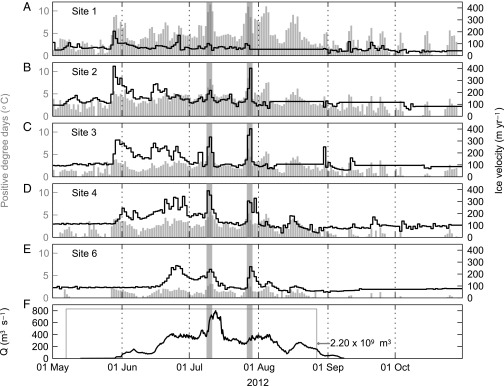
Transect observations during 2012. (A–E). Daily (24 h) along-track ice velocities (stepped black lines) and positive degree days (gray bars) for each transect site at which daily measurements were made. (F) Discharge hydrograph for Leverett Glacier (in cubic meters per second), with cumulative discharge between May 7 and August 27 (marked by gray box). The associated catchment is shown on Fig. 1. (A–F) Gray shading defines peak velocity response to July 12 and July 29 melt events (see text).
Here we concentrate on two specific aspects of hydrodynamic coupling during 2012 to give insight into the likely dynamic behavior of the ice sheet in a warming climate. We examine (i) the ice flow response to the extreme melt events of July 12 and July 29 (20), and (ii) the impact of unprecedented melt volumes (23) on total annual ice motion.
Enhanced ice flow lasting ∼2 d was associated with both extreme melt events (shaded periods in Figs. 2–4), with several characteristics common to both events. First, peak velocities occurred in advance of satellite-observed peak ice sheet melt extent (20), while proglacial discharge was still rising—2 d in advance of July 12, and 1 d in advance of July 29. Second, velocities increased at every site along the transect during the enhanced ice flow period. Third, at the majority of sites, velocities were lower after the enhanced ice flow period than before it (Fig. 2).
Fig. 4.
Observations around July 29 melt event. See A–F in Fig. 3 for details.
Before the July 12 melt event, sites up to 1,482 m above sea level (site 6) experienced positive air temperatures every day from June 10 (Fig. 2). Peak velocities during July 9–10 were coincident with a 2.3 °C increase in mean air temperature at our transect sites and a 73% increase in mean wind speed at Programme for Monitoring the Greenland Ice Sheet (PROMICE)/Greenland Analogue Project (GAP) K-transect sites (Fig. 1) compared with the previous 8 d. The mean daily transect velocity during July 9–10 was 61% greater than during the preceding 8 d, with sites 3 and 4 (794 and 1,061 m a.s.l, respectively) experiencing the highest peak velocities of 103 and 77% greater, respectively, than the previous 8 d (Fig. 3). By July 12, ice velocities were falling despite peaks in both ice sheet–wide melting and proglacial river discharge (∼800 m3 s−1; in excess of double that observed both at the start of the melt event and in previous years; ref. 19). Sites 1 and 2 returned to daily velocities within 10 m y−1 of July 1–8 mean velocities; and sites 3, 4, and 6 decreased to velocities at least 30 m y−1 slower than July 1–8 mean velocities.
Fig. 3.
Observations around July 12 melt event. (A–E) Near-surface air temperatures (dashed lines), daily (24 h) along-track ice velocities (stepped black lines) and short-term along-track ice velocities (gray lines) for each site at which daily measurements were made. Periods with inadequate quality observations removed. (F) Discharge hydrograph for Leverett Glacier (in cubic meters per second).(A–F) Gray shading defines the peak velocity response to the melt event (see text).
In contrast to the July 12 melt event, a period of falling air temperatures in the previous 15 d leading up to the July 29 melt event (as low as −7 °C at site 6) resulted in falling discharge to a minimum of 240 m3 s−1 on July 25, the lowest since June 18 (Fig. 2). During July 27–28, the mean transect air temperature rose by 4.4 °C compared with the previous 8 d, with associated, although lagged, increases in discharge and velocity (Fig. 4). Mean transect ice velocity on July 27–28 was 116% greater than during the preceding 8 d. At sites 2, 3, and 4, the velocity perturbation was short-lived, lasting ∼2 d before an abrupt drop in velocities that returned to within 20 m y−1 of preevent velocities. Site 6 slowed down more gradually after the July 28 peak. Unlike the July 12 melt event, river discharge remained close to its event peak of ∼400 m3 s−1 for 8 d following the July 29 melt event (Fig. 2F).
Increased ice velocities in the lead up to the July 12 and 29 melt events were clearly caused by a rapid increase in the rate of meltwater supply to the ice sheet bed forced by changes in the rate of surface melting. Although antecedent melt conditions and the absolute volumes of meltwater associated with each event were different, the nature and style of meltwater forcing, overwhelming the capacity of the hydrological system and leading to ice acceleration, were very similar, replicating responses observed previously (12, 16).
We estimated the potential contribution of each melt event to summer ice displacement by comparison with estimates of the projected ice displacement that would have occurred in the absence of the melt events. We used mean ice velocities at each site during the 8 d preceding each 2-d period of enhanced ice flow to estimate what the total displacement would likely have been through the 2-d enhanced ice flow period and the following 8 d in the absence of the enhanced ice flow period (see Materials and Methods for more information). Observations during the corresponding time periods are shown in Figs. 3 and 4. On average, the July 12 melt event forced only 7% more ice displacement over the 10-d period, and the July 29 melt event, which was preceded by lower melt rates than the July 12 event, forced 34% more ice displacement over the equivalent 10-d period. These findings reinforce the importance of antecedent melt rates (as opposed to simply meltwater volume) and thus drainage system efficiency in controlling the short-term dynamic response to variations in meltwater supply (26).
The second exceptional characteristic of 2012 was ice sheet–wide runoff of ∼3.9σ above the 1958–2011 mean (23). For comparison, Fig. 5 shows observations collected along our transect in the average melt year of 2009. Exceptional melting during 2012 resulted in a mean of 117% more ablation relative to 2009 along our transect (Fig. 5A) with bulk runoff from the local ice sheet margin (2.20 × 109 m3) 113% greater than 2009 (19). Summer velocities (Fig. 5B) at all but the lowest two sites were also higher in 2012 than in 2009. However, winter velocities at all sites were on average 11% lower in 2012 than in 2009, resulting in 6% less net annual ice motion along the transect in 2012–2013 than in 2009–2010 (Fig. 5). These observations support previous findings that stronger melting results in faster summers, but that faster summers are then offset by subsequent slower winter ice flow due to the evolution of a larger, more extensive subglacial drainage system that drains high basal water pressure regions (19). Our findings also support ice sheet modeling results (21), which suggest that enhanced basal lubrication will not cause substantial net mass loss from the ice sheet, and provide the observations which Shannon et al. (21) had stated were currently “insufficient to determine whether changes in subglacial hydraulics will limit the potential for the speedup of flow.”
Fig. 5.
(A) Annual (May 1–April 30) ablation in water equivalent meters for sites 2–7 in 2009 and 2012. (B) Summer (Sum, May 1–August 31), winter (Win, September 1–April 30), and annual (Ann, May 1–April 30) velocities for each site in 2009 and 2012.
Our findings demonstrate that despite the exceptional melting observed in 2012, annual ice motion along our transect was not enhanced relative to an average melt year (2009). These findings suggest that although hydrologically forced ice motion influences short-term and seasonal ice dynamics, land-terminating margins of the Greenland ice sheet are insensitive dynamically over annual timescales to melt volumes that are commensurate with temperature projections for 2100 (27). Furthermore, our data demonstrate that the importance of hydrologically forced ice motion over annual timescales can only be understood with reference to both summer and winter seasonal velocities due to their significant interannual variability. We also note that the effects of surface melt and oceanic forcing mechanisms on the dynamics of marine terminating glaciers in a warming climate remain unclear and should be a priority for future research.
Materials and Methods
Ice motion was recorded at seven sites, up to 1,716 m a.s.l elevation and 113 km from the ice sheet margin (Fig. 1). Dual-frequency GPS receivers mounted on poles frozen into the ice recorded position at 10-s intervals. Data were subsequently processed kinematically in overlapping 28-h windows using Track 1.21 (28) using International GNSS (Global Navigation Satellite System) Service precise orbits relative to an off-ice base station (Fig. 1), apart from August 12 to 29, 2012, when the Kellyville global GPS network station was used. Positions were filtered using a high-pass Gaussian filter to suppress high-frequency noise without distorting the long-term signal and then differenced every 24 h to calculate daily velocities (19). Short-term velocities were calculated at 1-min intervals and smoothed with a 6-h mean sliding window. Horizontal velocity uncertainties are approximately ±1 cm at each epoch and 5.2 m y−1 for daily velocities (10). Power failure prevented continuous recording of ice velocities at sites 5 and 7 during summer 2012 and at sites 1–3 in late summer (Fig. 1). The absolute displacements during these periods of power failure were still obtained at each site. The enhanced ice flow periods were defined in whole days for clarity and to make intercomparisons between sites more objective. Each enhanced ice flow period started when most sites showed a substantial increase in velocity on the previous day and ended on the last day before velocities at all sites decreased. We chose 8-d baseline periods for examining the ice displacement associated with each peak melt event as these represented the longest periods over which we could compare velocities without overlapping the periods associated with each melt event. The variability associated with choosing different lengths in baseline and enhanced ice flow period was insignificant in the context of the large differences in displacement exhibited by each event. Air temperatures were measured at sites 1, 3, and 6 using shielded Campbell Scientific T107 temperature sensors connected to Campbell Scientific CR800 data loggers, and at sites 2 and 4 using shielded HOBO U21-004 temperature sensors, situated ∼2 m above the ice sheet surface. Sensors sampled once per minute and recorded a mean value every 15 min. Air temperatures were then converted to positive degree days by calculating the mean of all positive values each day. Snow depths were measured at sites 2–7 just before the onset of the melt season, and seasonal ablation water equivalent totals were determined from ablation stakes at sites 2–7. To compare measurements of ice velocities and ablation made in 2009 and 2012, we calculated the percentage difference between the years at each site and then took the mean of those values to derive a transect average. The volume of meltwater draining from Leverett Glacier’s inferred hydrological catchment (Fig. 1) was measured using continuous water stage monitoring through a stable bedrock section. Stage was converted to discharge with a continuous stage–discharge curve obtained from repeat Rhodamine WT and Rhodamine B dye dilution injections undertaken throughout both melt seasons, following methods described previously (25). The normalized root mean squared deviation of the discharge record is estimated to be ±10%.
Acknowledgments
We thank the Leverett field camp members who helped with data acquisition. We acknowledge UK Natural Environment Research Council (NERC) Grants NE/F021399/1 (to P.W.N.) and NE/H024964/1 (to D.W.F.M.); NERC studentships NE/152830X/1 and NE/J500021/1 (to A.J.T.) and NE/H526794/1 (to I.D.B.); Edinburgh University Moss Scholarships (to A.J.T., T.R.C., and I.D.B.) and Development Trust; The Carnegie Trust (P.W.N.); Mackay Greenland Fund (A.J.T.); Research Councils Academic Fellowship (to M.A.K.); and Australian Research Council Future Fellowship FT110100207 (to M.A.K.). GPS equipment and training were provided by the NERC Geophysical Equipment Facility loan 868. Wind speed data from PROMICE and the GAP were provided by the Geological Survey of Greenland on www.promice.dk.
Footnotes
The authors declare no conflict of interest.
This article is a PNAS Direct Submission.
References
- 1.Rignot E, Velicogna I, van den Broeke MR, Monaghan A, Lenaerts J. Acceleration of the contribution of the Greenland and Antarctic ice sheets to sea level rise. Geophys Res Lett. 2011;38:1–5. [Google Scholar]
- 2.Shepherd A, et al. A reconciled estimate of ice-sheet mass balance. Science. 2012;338(6111):1183–1189. doi: 10.1126/science.1228102. [DOI] [PubMed] [Google Scholar]
- 3.Sasgen I, et al. Timing and origin of recent regional ice-mass loss in Greenland. Earth Planet Sci Lett. 2012;333:293–303. [Google Scholar]
- 4.Hanna E, et al. Greenland ice sheet surface mass balance 1870 to 2010 based on twentieth century reanalysis, and links with global climate forcing. J Geophys Res. 2011;116:D24121. [Google Scholar]
- 5.Hanna E, Mernild SH, Cappelen J, Steffen K. Recent warming in Greenland in a long-term instrumental (18812012) climatic context: I. Evaluation of surface air temperature records. Environ Res Lett. 2012;7:045404. [Google Scholar]
- 6.Fettweis X, Tedesco M, van den Broeke M, Ettema J. Melting trends over the Greenland ice sheet (1958-2009) from spaceborne microwave data and regional climate models. Cryosphere. 2011;5:359–375. [Google Scholar]
- 7.Pritchard HD, Arthern RJ, Vaughan DG, Edwards LA. Extensive dynamic thinning on the margins of the Greenland and Antarctic ice sheets. Nature. 2009;461(7266):971–975. doi: 10.1038/nature08471. [DOI] [PubMed] [Google Scholar]
- 8.Zwally HJ, et al. Surface melt-induced acceleration of Greenland ice-sheet flow. Science. 2002;297(5579):218–222. doi: 10.1126/science.1072708. [DOI] [PubMed] [Google Scholar]
- 9.Andersen ML, et al. Spatial and temporal melt variability at Helheim Glacier, East Greenland, and its effect on ice dynamics. J Geophys Res. 2010;115:F04041. [Google Scholar]
- 10.Bartholomew I, et al. Seasonal variations in Greenland Ice Sheet motion: Inland extent and behaviour at higher elevations. Earth Planet Sci Lett. 2011;307:271–278. [Google Scholar]
- 11.Sole AJ, et al. Seasonal speedup of a Greenland marine-terminating outlet glacier forced by surface melt-induced changes in subglacial hydrology. J Geophys Res. 2011;116:1–11. [Google Scholar]
- 12.Bartholomew I, et al. Short-term variability in Greenland ice sheet motion forced by time-varying meltwater drainage: Implications for the relationship between subglacial drainage system behavior and ice velocity. J Geophys Res. 2012;117:F03002. [Google Scholar]
- 13.Iken A, Bindschadler RA. Combined measurements of subglacial water pressure and surface velocity of Findelengletscher, Switzerland: Conclusions about drainage system and sliding mechanism. J Glaciol. 1986;32:101–119. [Google Scholar]
- 14.Bartholomew I, et al. Seasonal evolution of subglacial drainage and acceleration in a Greenland outlet glacier. Nat Geosci. 2010;3:408–411. [Google Scholar]
- 15.Röthlisberger H, Lang H. Glacial Hydrology. In: Gurnell A, Clark M, editors. Glacio-Fluvial Sediment Transfer: An Alpine Perspective. Chichester, UK: John Wiley and Sons; 1987. pp. 207–284. [Google Scholar]
- 16.Cowton T, et al. Evolution of drainage system morphology at a land-terminating Greenland outlet glacier. J Geophys Res. 2013;118:29–41. [Google Scholar]
- 17.Sundal AV, et al. Melt-induced speed-up of Greenland ice sheet offset by efficient subglacial drainage. Nature. 2011;469(7331):521–524. doi: 10.1038/nature09740. [DOI] [PubMed] [Google Scholar]
- 18.van de Wal RSW, et al. Large and rapid melt-induced velocity changes in the ablation zone of the Greenland Ice Sheet. Science. 2008;321(5885):111–113. doi: 10.1126/science.1158540. [DOI] [PubMed] [Google Scholar]
- 19.Sole A, et al. Winter motion mediates dynamic response of the Greenland ice sheet to warmer summers. Geophys Res Lett. 2013;40:3940–3944. [Google Scholar]
- 20.Nghiem SV, et al. The extreme melt across the Greenland ice sheet in 2012. Geophys Res Lett. 2012;39:L20502. [Google Scholar]
- 21.Shannon SR, et al. Enhanced basal lubrication and the contribution of the Greenland ice sheet to future sea-level rise. Proc Natl Acad Sci USA. 2013;110(35):14156–14161. doi: 10.1073/pnas.1212647110. [DOI] [PMC free article] [PubMed] [Google Scholar]
- 22.Fettweis X, et al. Brief communication “Important role of the mid-tropospheric atmospheric circulation in the recent surface melt increase over the Greenland ice sheet”. Cryosphere. 2013;7:241–248. [Google Scholar]
- 23.Tedesco M, et al. Evidence and analysis of 2012 Greenland records from spaceborne observations, a regional climate model and reanalysis data. Cryosphere. 2013;7:615–630. [Google Scholar]
- 24.Bennartz R, et al. July 2012 Greenland melt extent enhanced by low-level liquid clouds. Nature. 2013;496(7443):83–86. doi: 10.1038/nature12002. [DOI] [PubMed] [Google Scholar]
- 25.Bartholomew I, et al. Supraglacial forcing of subglacial drainage in the ablation zone of the Greenland ice sheet. Geophys Res Lett. 2011;38:L08502. [Google Scholar]
- 26.Schoof C. Ice-sheet acceleration driven by melt supply variability. Nature. 2010;468(7325):803–806. doi: 10.1038/nature09618. [DOI] [PubMed] [Google Scholar]
- 27.Meehl G, et al. Global Climate Projections. In: Solomon S, et al., editors. Climate Change 2007: The Physical Science Basis. Contribution of Working Group I to the Fourth Assessment Report of the Intergovernmental Panel on Climate Change. Cambridge University Press; 2007. [Google Scholar]
- 28.Chen G. 1999. GPS kinematic positioning for the airborne laser altimetry at Long Valley, California. Ph.D. thesis (Massachusetts Institute of Technology)
- 29.Palmer S, Shepherd A, Nienow P, Joughin I. Seasonal speedup of the Greenland Ice Sheet linked to routing of surface water. Earth Planet Sci Lett. 2011;302:423–428. [Google Scholar]
- 30.Allen C. 2011. IceBridge MCoRDS L2 ice thickness 2010 and 2011. Digital media http://nsidc.org/data/irmcr2.html.



